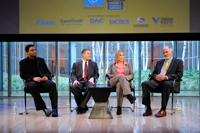
“Innovation and the Eye,” panelist are (l to r) Ramesh Raskar, PhD, co-founder of EyeNetra and associate professor at MIT Media Lab; Steve Willey, co-founder and CEO of Innovega; Barbara Barclay, general manager of Tobii North America; and Jim Little, VP of R&D for Second Sight. |